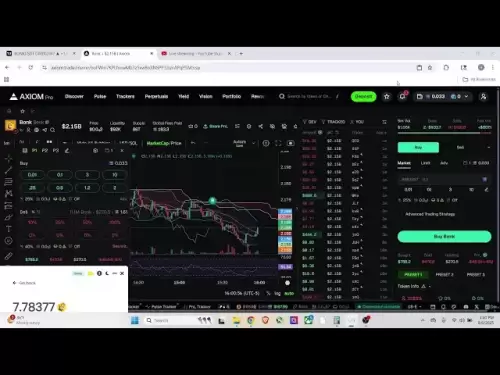-
 Bitcoin
Bitcoin $116700
2.16% -
 Ethereum
Ethereum $3830
5.76% -
 XRP
XRP $3.082
4.56% -
 Tether USDt
Tether USDt $1.000
0.04% -
 BNB
BNB $777.8
1.96% -
 Solana
Solana $173.2
5.46% -
 USDC
USDC $0.0000
0.02% -
 Dogecoin
Dogecoin $0.2146
6.85% -
 TRON
TRON $0.3384
0.92% -
 Cardano
Cardano $0.7676
5.51% -
 Hyperliquid
Hyperliquid $39.28
4.90% -
 Sui
Sui $3.723
9.07% -
 Stellar
Stellar $0.4164
6.32% -
 Chainlink
Chainlink $17.36
5.78% -
 Bitcoin Cash
Bitcoin Cash $580.9
3.62% -
 Hedera
Hedera $0.2544
5.50% -
 Ethena USDe
Ethena USDe $1.001
0.02% -
 Avalanche
Avalanche $22.81
3.81% -
 Litecoin
Litecoin $120.8
3.60% -
 UNUS SED LEO
UNUS SED LEO $8.956
-0.35% -
 Toncoin
Toncoin $3.311
4.28% -
 Shiba Inu
Shiba Inu $0.00001266
4.15% -
 Uniswap
Uniswap $10.10
5.97% -
 Polkadot
Polkadot $3.786
4.80% -
 Dai
Dai $1.000
0.01% -
 Monero
Monero $280.4
-4.02% -
 Bitget Token
Bitget Token $4.405
1.69% -
 Cronos
Cronos $0.1480
5.13% -
 Pepe
Pepe $0.00001087
5.67% -
 Ethena
Ethena $0.6348
11.62%
How to seize SOL's short-term arbitrage opportunities?
SOL's fast transactions and low fees create short-term arbitrage opportunities; traders can profit by buying low on one exchange and selling high on another.
Apr 20, 2025 at 07:22 am

Introduction to SOL's Short-Term Arbitrage Opportunities
SOL, the native cryptocurrency of the Solana blockchain, has gained significant attention due to its fast transaction speeds and low fees. This has created numerous short-term arbitrage opportunities for traders looking to capitalize on price discrepancies across different exchanges. Short-term arbitrage involves buying SOL at a lower price on one exchange and selling it at a higher price on another, thus profiting from the price difference. This article will guide you through the process of seizing these opportunities effectively.
Understanding SOL's Market Dynamics
To successfully engage in short-term arbitrage with SOL, it's crucial to understand the market dynamics that affect its price. SOL's price can vary significantly across different exchanges due to factors such as liquidity, trading volume, and market sentiment. Additionally, the speed of the Solana blockchain allows for rapid transactions, which can be advantageous for arbitrageurs. Monitoring these factors and understanding how they influence SOL's price is essential for identifying profitable arbitrage opportunities.
Identifying Arbitrage Opportunities
The first step in seizing SOL's short-term arbitrage opportunities is to identify price discrepancies. This can be done by using various tools and platforms that track prices across multiple exchanges. Here are some steps to follow:
- Use arbitrage bots and software: Tools like Coinigy, Crypto Arbitrage Tracker, and Blackbird can automatically scan multiple exchanges for price differences.
- Monitor exchange rates manually: If you prefer a hands-on approach, you can manually check the prices on exchanges like Binance, Coinbase, and Kraken.
- Set up price alerts: Many trading platforms allow you to set up alerts for specific price thresholds, which can notify you when an arbitrage opportunity arises.
Executing the Arbitrage Trade
Once you've identified a price discrepancy, the next step is to execute the arbitrage trade. Here's a detailed guide on how to do it:
- Choose the right exchanges: Ensure that the exchanges you are using support SOL and have sufficient liquidity. Popular choices include Binance, Coinbase, and FTX.
- Fund your accounts: Transfer the necessary funds to both exchanges. This may involve converting your fiat currency to SOL or another cryptocurrency that can be traded for SOL.
- Execute the buy order: On the exchange where SOL is cheaper, place a buy order for the amount you wish to arbitrage. Make sure to account for any fees.
- Execute the sell order: Simultaneously, place a sell order on the exchange where SOL is more expensive. Again, consider the fees associated with the trade.
- Transfer profits: After the trades are complete, transfer your profits back to your preferred wallet or exchange.
Managing Risks and Fees
Arbitrage trading is not without risks. Fees can significantly impact your profits, so it's important to consider them when calculating potential gains. Here are some tips for managing risks and fees:
- Calculate net profit: Always subtract the fees from both the buy and sell transactions to determine your net profit.
- Use limit orders: To ensure you get the desired price, use limit orders rather than market orders, which can be affected by sudden price movements.
- Monitor market conditions: Keep an eye on market conditions and be prepared to adjust your strategy if necessary. Sudden market shifts can turn a profitable arbitrage opportunity into a loss.
Tools and Resources for SOL Arbitrage
To maximize your chances of success in SOL arbitrage, it's beneficial to use a variety of tools and resources. Here are some recommendations:
- Arbitrage calculators: Websites like CoinArbitrageBot offer calculators that help you determine the profitability of an arbitrage trade.
- Trading APIs: Many exchanges provide APIs that can be integrated with trading bots to automate the arbitrage process.
- Community forums and social media: Platforms like Reddit and Twitter can provide real-time insights and tips from other arbitrage traders.
Case Study: A Successful SOL Arbitrage Trade
To illustrate how SOL arbitrage works in practice, let's look at a hypothetical case study. Suppose you notice that SOL is trading at $100 on Exchange A and $102 on Exchange B. You decide to buy 10 SOL on Exchange A for $1,000 and sell it on Exchange B for $1,020. After accounting for fees of 0.1% on both exchanges, your net profit would be:
- Buy fee on Exchange A: $1,000 * 0.1% = $1
- Sell fee on Exchange B: $1,020 * 0.1% = $1.02
- Total fees: $1 + $1.02 = $2.02
- Net profit: $1,020 - $1,000 - $2.02 = $17.98
This example demonstrates how even small price differences can be profitable when executed correctly.
Frequently Asked Questions
Q: How often do SOL arbitrage opportunities occur?
A: SOL arbitrage opportunities can occur frequently, especially during periods of high market volatility. However, the frequency can vary based on market conditions and the specific exchanges you are monitoring.
Q: Can I automate SOL arbitrage trading?
A: Yes, you can automate SOL arbitrage trading using trading bots and APIs. However, it's important to thoroughly test and monitor your automated systems to ensure they are functioning correctly and managing risks effectively.
Q: What is the minimum amount of SOL needed to start arbitrage trading?
A: The minimum amount of SOL required for arbitrage trading can vary depending on the exchanges and the specific arbitrage opportunity. Generally, starting with a small amount, such as 1-5 SOL, can help you gain experience without significant risk.
Q: Are there any legal considerations for SOL arbitrage trading?
A: Legal considerations for SOL arbitrage trading can vary by jurisdiction. It's important to research and comply with the regulations in your area, such as those related to cryptocurrency trading and taxation.
Disclaimer:info@kdj.com
The information provided is not trading advice. kdj.com does not assume any responsibility for any investments made based on the information provided in this article. Cryptocurrencies are highly volatile and it is highly recommended that you invest with caution after thorough research!
If you believe that the content used on this website infringes your copyright, please contact us immediately (info@kdj.com) and we will delete it promptly.
- Ollama Turbo & GPT-OSS: Revolutionizing AI Model Accessibility and Speed
- 2025-08-07 20:29:33
- Bitcoin Ordinals: NFTs Evolving Bitcoin or a Fleeting Fad?
- 2025-08-07 20:29:33
- BlockchainFX, Bitcoin Swift, Crypto Presales: What's the Hype?
- 2025-08-07 19:10:13
- Pepe Dollar (PEPD) vs. SPX6900: The Meme Coin Battle of 2025
- 2025-08-07 19:50:12
- XRP Investment Regret: Are You Missing Out on the Next Big Thing?
- 2025-08-07 19:50:12
- XRPINU: More Than Just a Meme? Roadmap, Liquidity, and the Future of Funny Money
- 2025-08-07 19:56:46
Related knowledge

How to avoid common crypto investment mistakes?
Jul 13,2025 at 01:35am
Understanding the Risks of Crypto InvestmentInvesting in cryptocurrency can be highly rewarding, but it also comes with significant risks. One of the ...

What is a long-short crypto strategy?
Jul 15,2025 at 10:56am
Understanding the Basics of a Long-Short Crypto StrategyA long-short crypto strategy is an investment approach where traders simultaneously take long ...

What is a long-short crypto strategy?
Jul 11,2025 at 01:28pm
Understanding the Basics of Long-Short Crypto StrategyA long-short crypto strategy is an investment approach where traders take both long and short po...

How to use the RSI indicator for crypto?
Jul 12,2025 at 03:56pm
Understanding the RSI Indicator in Cryptocurrency TradingThe Relative Strength Index (RSI) is a momentum oscillator used to measure the speed and chan...

Is copy trading a good strategy for crypto beginners?
Jul 12,2025 at 08:28am
Understanding Copy Trading in the Cryptocurrency MarketCopy trading is a strategy where novice traders replicate the trades of experienced investors a...

How to build a crypto portfolio with $1000?
Jul 13,2025 at 08:14pm
Understanding the Basics of Cryptocurrency InvestmentBuilding a crypto portfolio with $1000 starts with understanding the fundamentals of cryptocurren...

How to avoid common crypto investment mistakes?
Jul 13,2025 at 01:35am
Understanding the Risks of Crypto InvestmentInvesting in cryptocurrency can be highly rewarding, but it also comes with significant risks. One of the ...

What is a long-short crypto strategy?
Jul 15,2025 at 10:56am
Understanding the Basics of a Long-Short Crypto StrategyA long-short crypto strategy is an investment approach where traders simultaneously take long ...

What is a long-short crypto strategy?
Jul 11,2025 at 01:28pm
Understanding the Basics of Long-Short Crypto StrategyA long-short crypto strategy is an investment approach where traders take both long and short po...

How to use the RSI indicator for crypto?
Jul 12,2025 at 03:56pm
Understanding the RSI Indicator in Cryptocurrency TradingThe Relative Strength Index (RSI) is a momentum oscillator used to measure the speed and chan...

Is copy trading a good strategy for crypto beginners?
Jul 12,2025 at 08:28am
Understanding Copy Trading in the Cryptocurrency MarketCopy trading is a strategy where novice traders replicate the trades of experienced investors a...

How to build a crypto portfolio with $1000?
Jul 13,2025 at 08:14pm
Understanding the Basics of Cryptocurrency InvestmentBuilding a crypto portfolio with $1000 starts with understanding the fundamentals of cryptocurren...
See all articles

























































































